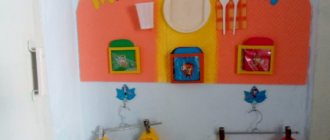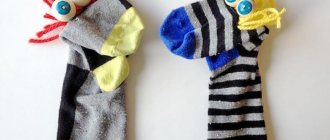Summary of educational activities with children of the preparatory group “Emergencies - what is it?”
Goal: to form an understanding of emergency situations.
Tasks:
Educational: introduce situations that can be called “emergency”, natural phenomena that cause harm to humans.
Developmental : develop the ability to find solutions in difficult situations, apply basic first aid techniques.
Educational : to cultivate a sense of mutual assistance and mutual assistance.
Progress of OOD
Slide 1
Educator: Guys, today we will talk about dangerous situations, and what should be done in such cases.
Hazards may arise due to human fault. Name them.
Children: Fire, gas explosion, flood, road accident, etc.
Educator: These are situations that arose through our fault, and they threaten one or more people. This situation includes a fire.
Slide 2, Slide 3.
Educator: What can cause a fire?
Children: From matches, from electrical appliances, from a gas stove, etc.
Slide 4.
Educator: It is imperative to know the rules of how to behave during a fire. Let's remember them.
Rules:
Let's call the adults.
If the fire is small, you can try to extinguish it immediately by throwing a thick cloth, a blanket over it, or pouring a pan of water (not on electrical appliances).
If the fire does not go out immediately, immediately run away from the house to a safe place and only after that call the fire department by phone “01” or ask your neighbors about it.
If you cannot escape from a burning apartment, immediately call “01” and tell the firefighters the exact address and number of your apartment.
After that, call neighbors and passersby for help from the window.
If you feel like you are choking on smoke, squat down or crawl towards the exit - there is less smoke below. We don’t hide under beds, tables or in corners.
When adults come to help or firefighters arrive, we obey them in everything.
Educator: Guys, there are dangerous situations that arise due to changes in natural phenomena: wind, water, snow, earth, etc. They are called emergency situations.
An emergency is a danger that threatens many people.
Name emergencies that occur due to natural changes. Questions will help you with this.
— Temporary flooding of land due to rising water. Flood.
- Very strong wind. Hurricane.
— A very strong storm at sea. Storm.
— Rapid movement of the earth's crust caused by shocks from below. Earthquake.
What emergencies happen in our city?
Children: Flood.
Slide 5.
Educator: What causes flooding?
Children: Due to heavy rains and rapid melting of snow.
Educator: As a result of the flood, houses and buildings, bridges are destroyed; erosion of railways and roads; crop destruction; people and animals die.
Educator: What structure helps the city avoid flooding? Dam.
Slide 6.
A dam is an earthen, stone or other material embankment on the bank of a river that protects the bank from flooding and serves to retain water.
Slide 7.
Actions during a flood:
Do not panic.
Collect documents, necessary things, drinking water, medicines, food supply for 2-3 days. If time permits, close the windows with shutters or boards.
Go to the upper floors of the building; in a one-story house, climb onto the roof.
Until help arrives, stay on the upper floors, roofs or other elevated areas and signal to rescuers so that they can quickly find you.
In the forest - go to an elevated place, mountain, hill, climb a tree.
If you find yourself in water, you need to swim with the flow to the nearest non-flooded area, you need to hold on to non-sinking objects floating by.
Educator: Guys, the wind can also harm a person.
Slide 8.
Our city also experiences hurricanes.
What damage can a hurricane cause?
Children: Knock down a tree, an advertisement, tear off a roof, etc.
Slide 9.
Slide 10.
Educator: If a hurricane hits and you are at home in your apartment, what should you do?
Close all windows and doors, it is better to turn off gas and electricity, and stock up on water. It is best to take shelter in the basement or in the living quarters of the first floor.
If you are outside, in the forest?
Find shelter in other durable spaces. You should understand that the car will not protect you in hurricane winds, so it is better to leave it, the wind will easily lift the car into the air.
Avoid power lines (downed power lines can be fatal to those nearby).
Avoid billboards, signs, kiosks, cars, etc. (all this can be picked up by the wind and hit you).
Stay away from isolated trees (the wind can easily knock them over).
If you couldn’t find shelter in a building, find a ditch or hole of some kind. Lie on your stomach and cover your head with your hands,
Slide 11.
Educator: Guys, rescuers always come to our aid.
This profession is considered one of the most dangerous. Rescuers come to the aid of people in trouble, often risking their own lives.
Let's play the game "We are rescuers"
Goal: to consolidate children's knowledge about the professions of the Ministry of Emergency Situations, their purpose and the availability of items that help these people in their work.
Rules of the game:
Children take turns tossing the cube. The number rolled on the die indicates the sector of the circle with the same number. The child explains why and in what situation the items depicted in this sector are intended for rescuers.
Sector 1: FOREST FIRE: a bulldozer for clearing strips of bushes and rubble, also digging in the forest so that the fire does not move further; use aircraft equipped with special containers for collecting, transporting and discharging water and fire extinguishing agents; forest fire extinguishers resemble a pump.
Sector 2: FIRE: fire extinguisher, cone bucket.
Sector 3: INCIDENT IN THE MOUNTAINS: fell into a gorge: cable, rope to reach, lift a person from the gorge, onto the mountain; helicopter, horse helps to get to the scene.
Sector 4: WHEN THE SHIP SINKED: fins, scuba gear (compressed air tank, snorkel), wetsuit.
Sector 5: FLOOD: life jacket, ring, boat.
Sector 6: EARTHQUAKE, AVALANCHE, DEBACLE, EXPLOSIONS: search dog, stretcher, shovel.
Educator: In order for a rescuer to cope with his work, he must be strong and resilient. Rescuers do a lot of sports and train. Now we will hold competitions for young rescuers.
Relay race “Who will sound the alarm faster?”
From the starting point, the participant runs to the cube on which the triangle lies, gives a signal (rings the triangle) and runs back. Passes the baton to the next one.
Relay race “Sorting out rubble”
The explosion destroyed the house. Rescuers need to quickly clear the rubble.
A child with a toy car “drives up” to a “destroyed house.” He puts one “brick” in the back of the car and takes it to a certain place. Passes the baton to the next one.
Relay race "First aid"
Very often in emergency situations, assistance is needed for weaker or injured people. Rescuers must come to the aid of the victims and provide medical assistance.
Educator: Today we got acquainted with natural disasters, remember the danger and always follow the safety rules!





